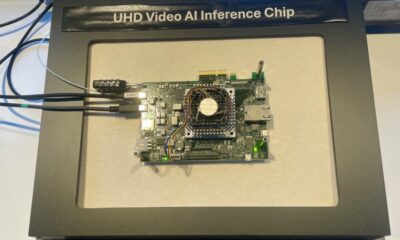Robotics
Intel’s New Neuromorphic Chips are 1,000 Times Faster Than Normal CPUs

Intel’s new system codenamed Pohoiki Beach will be at the Consumer Electronics Show (CES) in Las Vegas. The device is built from 64 Loihi research chips, and the goal is for it to simulate the human brain when it comes to learning ability and energy efficiency. These neuromorphic chips are a simpler version of the way neurons and synapses function in the brain.
Rich Uhlig, managing director of Intel Labs, spoke on the new technology.
“We are impressed with the early results demonstrated as we scale Loihi to create more powerful neuromorphic systems. Pohoiki Beach will now be available to more than 60 ecosystem partners, who will use this specialized system to solve complex, compute-intensive problems.”
The new AI neuromorphic chip can perform data-crunching tasks 1,000 times faster than normal processors like CPUs and GPUs while using a lot less power.
The way it is based on brain neurons is not something entirely new. Many AI algorithms simulate neural networks in their programs. They use parallel processing for recognizing objects in images and words in speech. The new neuromorphic chips put these neural networks into silicon. While they are less flexible and powerful than some of the best general-purpose chips, they really perform when specialized in specific tasks. The new AI chip from Intel is 10,000 times more efficient than general processors. Since they are so energy efficient, the technology will be ideal for mobile devices, vehicles, industrial equipment, cybersecurity, and smart homes. AI researchers have already begun to use the system for things like improving prosthetic limbs so that they can adapt better to uneven ground, as well as creating digital maps to be used by self-driving cars.
Chris Eliasmith, co-CEO of Applied Brain Research and professor at the University of Waterloo, is one of the several researchers using the new technology.
“With the Loihi chip we’ve been able to demonstrate 109 times lower power consumption running a real-time deep learning benchmark compared to a GPU, and 5 times lower power consumption compared to specialized IoT interface hardware…Even better, as we scale the network up by 50 times, Loihi maintains real-time performance results and uses only 30 percent more power, whereas the IoT hardware uses 500 percent more power and is no longer real-time,” Chris Eliasmith said.
Konstantinos Michmizos is a professor of Rutgers University, and his lab does work with SLAM which will be presented at the International Conference on Intelligent Robots and Systems (IROS) in November.
“Loihi allowed us to realize a spiking neural network that imitates the brain’s underlying neural representations and behavior. The SLAM solution emerged as a property of the network’s structure. We benchmarked the Loihi-run network and found it to be equally accurate while consuming 100 times less energy than a widely used CPU-run SLAM method for mobile robots,” he said.
As of right now, Pohoiki Beach is an 8 million neuron system. Rich Uhlig, head of Intel Labs, thinks that the company will be able to create a system that is able to simulate 100 million neurons by the end of 2019. This new technology will be able to be used by researchers for a wide range of things such as improvement of robot arms. These new developments and research are leading to what will likely be the commercialization of neuromorphic technology.
According to the company, “Later this year, Intel will introduce an even larger Loihi system named Pohoiki Springs, which will build on the Pohoiki Beach architecture to deliver an unprecedented level of performance and efficiency for scaled-up neuromorphic workloads.”











